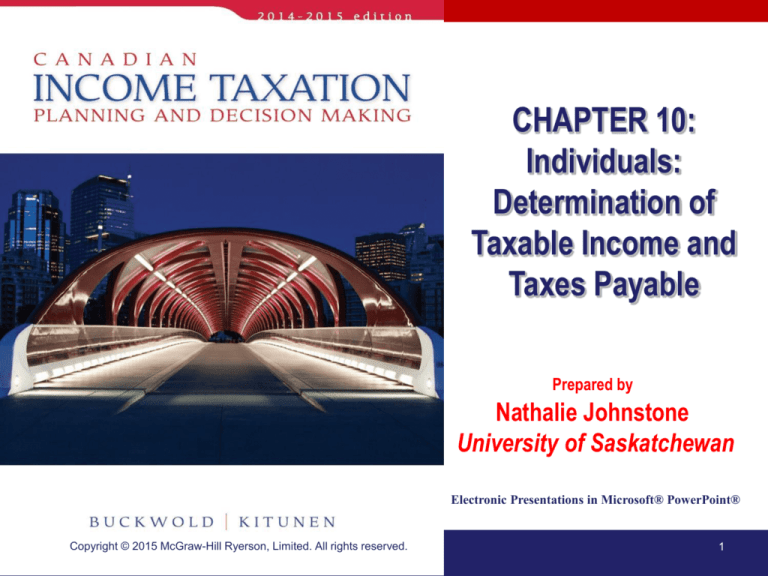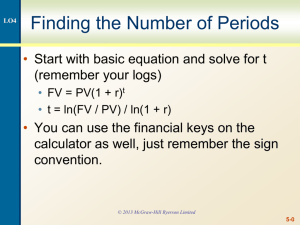
CHAPTER 10:
Individuals:
Determination of
Taxable Income and
Taxes Payable
Prepared by
Nathalie Johnstone
University of Saskatchewan
Electronic Presentations in Microsoft® PowerPoint®
Copyright © 2015 McGraw-Hill Ryerson, Limited. All rights reserved.
1
Individuals: Determination of Taxable Income and
Taxes Payable
I. Determination of Taxable Income
II. Loss Carry-Overs
III. Loss Utilization – Impact on Decision
Making
IV. The Capital Gain Deduction
V. Calculation of Tax for Individuals
VI. Special Adjustments to the Tax
Calculation
VII. Final Returns of Deceased Taxpayers
Copyright © 2015 McGraw-Hill Ryerson, Limited. All rights reserved.
2
Taxable Income Formula - revisited
Net income for tax purposes:
a) Employment Income
Business Income
Property Income
Other items
Plus
b) Net Capital Gains- ITA 3(b)(i)(B)
Less
c) Other items of deductions
Less
d) Aggregate of losses from Employment
Business, Property and ABILS
= Net Income for tax purposes
Copyright © 2015 McGraw-Hill Ryerson, Limited. All rights reserved.
3
Taxable Income Formula
Net income for tax purposes
Less
2. Special Reductions:
a)
b)
c)
d)
e)
=
XXX
Stock Options deduction –ITA 110(1)(d),(d.1)
Home Relocation loan deduction
Losses not utilized in other years
ITA 111
Social Assistance, Worker’s compensation
and amounts exempt by treaty.
Lifetime capital gain deduction
ITA 110.6
(XXX)
(XXX)
(XXX)
(XXX)
(XXX)
Taxable Income
Copyright © 2015 McGraw-Hill Ryerson, Limited. All rights reserved.
4
II.
Loss Carry-Overs
• If you have a loss in the current year, you can carry it
over to other years to reduce income and taxes.
• Net Capital Losses:
– Loss on sale of capital properties
• can be carried back three years and
• forward indefinitely BUT only deductible against
capital gains
• Non Capital Losses:
- Loss From business, property and employment
• can be carried back three years and forward twenty
years - used against any source of income
Copyright © 2015 McGraw-Hill Ryerson, Limited. All rights reserved.
5
Farm Losses and Restricted Farm Losses
NOT EXAMINABLE
• Farm losses - chief source of income is farming or
fishing.
• Farm losses are treated the same as business
losses.
Copyright © 2015 McGraw-Hill Ryerson, Limited. All rights reserved.
6
III.
Loss Utilization – Impact on Decision Making
• The risk of loss expiration:
– can be minimized by creating taxable income or
– reduce deductible expenses, thereby
– permitting a greater amount of the loss carry-over to be
used.
Copyright © 2015 McGraw-Hill Ryerson, Limited. All rights reserved.
7
IV.
The Capital Gain Deduction
• Final step is to apply the capital gain deduction.
• Lifetime Capital Gain Deduction is available only for
– Qualified small business corporation shares and
– qualified farm property.
– Deduction is one-half of $800,000 after 2013
– ITA 110.6(4)
• deductible from taxable income.
• The deduction is discretionary.
Copyright © 2015 McGraw-Hill Ryerson, Limited. All rights reserved.
8
IV.
The Capital Gain Deduction
A small business corporation is:
– a private corporation that is Canadian-controlled and
– that uses all or substantially all of its assets (at least
90%) to conduct an active business.
Qualified farm property includes:
– real property,
– eligible capital property used in farming business,
– share of a family farm corporation, and
– Interest in a farm partnership.
Copyright © 2015 McGraw-Hill Ryerson, Limited. All rights reserved.
9
Income tax is imposed by the federal and provincial
governments:
Federal tax - % of taxable income
Provincial tax - % of taxable income
Copyright © 2015 McGraw-Hill Ryerson, Limited. All rights reserved.
10
Determination of Tax for an Individual
Federal tax:
Primary federal tax
First-category tax credits
Basic federal tax
Second-category tax credits
Total federal tax
Provincial tax:
Primary provincial tax
Provincial surtax
Specific provincial tax credits
Combined federal and provincial tax
Copyright © 2015 McGraw-Hill Ryerson, Limited. All rights reserved.
XX
(XX)
XX
(XX)
XX
XX
XX
(XX)
XX
XX
11
Primary Federal Tax
• Progressively higher tax rates to higher levels of
annual income.
• Each rate of tax is applied separately to the portion
of the individual’s income that falls within the
applicable range.
Copyright © 2015 McGraw-Hill Ryerson, Limited. All rights reserved.
12
V. Calculation of Tax for Individuals
Taxable Income Range (2014)
Rate
Up to $43,953
15%
$43,954 to 87,907
22%
$ 87,908 to 136,270
26%
Over $ 136,270
29%
Copyright © 2015 McGraw-Hill Ryerson, Limited. All rights reserved.
13
First Category of Federal Tax Credits
Basic
• 15% x $11,138= $1,671
Spouse or equivalent to spouse
• 15% x $11,138 = $1,671
• Reduced by 15% of the spouse’s net income.
• Child Credit
– A credit of $338 (15% of $2,255) for each child:
Copyright © 2015 McGraw-Hill Ryerson, Limited. All rights reserved.
14
First Category of Federal Tax Credits
CPP and EI
– 15% x CPP and EI contributions
Medical expenses
– 15% x qualified medical expenses exceeding:
• either 3% of the taxpayer’s net income, or
• $2,171 whichever is less.
Copyright © 2015 McGraw-Hill Ryerson, Limited. All rights reserved.
15
First Category of Federal Tax Credits
Employment Credit
– Employed individuals = 15% x $1,127= $169
Public Transit Pass
– 15% of monthly cost for unlimited travel
• Local busses, streetcar, subway, commuter train and
ferries
Children’s Fitness Credit
– 15% of fees paid up to $500 for
• Physical activity program
Children’s arts tax credit
– 15% of fees paid up to $500
• Artistic, cultural, recreational activities.
Copyright © 2015 McGraw-Hill Ryerson, Limited. All rights reserved.
16
First Category of Federal Tax Credits
Caregiver
Provide in-home care for::
a parent or grandparent who is 65 or older, or
dependent relative who is infirm
$680 tax credit against federal tax.
Reduced by 15% of the dependent’s income in excess of
$15,472.
Copyright © 2015 McGraw-Hill Ryerson, Limited. All rights reserved.
17
First Category of Federal Tax Credits
Tuition fees
– attend a university, college, or other certified postsecondary institution = 15% x tuition fees paid.
Education amount and textbook credit
– Full-time students – 15% x $465 x months FT
– Part-time education – 15% x $140 x months PT
The unused portion is transferable - up $750 (15% x
$5,000) annually to a spouse, parent, or grandparent.
Less any credits used by student.
Alternatively, the student may keep the unused credit and
carry it forward indefinitely.
Copyright © 2015 McGraw-Hill Ryerson, Limited. All rights reserved.
18
First Category of Federal Tax Credits
Student loan interest
– Entitled to deduct 15% x interest paid on student loans.
– Only on interest on loans under:
• Canada Student Loan Program and
• Provincial student loan programs.
– The credit may be claimed in the year of interest
payment or in any of the following five years.
Copyright © 2015 McGraw-Hill Ryerson, Limited. All rights reserved.
19
First Category of Federal Tax Credits
Charitable donations
– 15% x first $200 of annual contributions and
– 29% x the remainder.
– Unused Donations can be carried forward for 5 years
• Additional tax credit of 25% for first time donor:
– 40% (15% + 25%) on first $200
– 54% (29% + 25%) on remaining
• First-time home buyer’s credit
– Maximum Credit = 15% x $5,000.
– To claim cannot have owned a home in the past
Copyright © 2015 McGraw-Hill Ryerson, Limited. All rights reserved.
20
First Category of Federal Tax Credits
Dividend tax credit – Eligible Corporations(mostly
public companies
– Equal to 15% (6/11 x 38%) of the taxable amount of
dividends received from Canadian corporations.
Dividend tax credit – Non-Eligible
Corporations(mostly private companies)
– Equal to 11% (13/18 x 18%) of the taxable amount of
dividends received from Canadian corporations.
Copyright © 2015 McGraw-Hill Ryerson, Limited. All rights reserved.
21
Second Category of Federal Tax Credits
Political contributions
• Based on a graduated
scale.
Max. of $650/year
• ITA 126 - Foreign tax
credit
• Investment tax credits
• Logging tax credit
• Labour-sponsored fund
credit
Copyright © 2015 McGraw-Hill Ryerson, Limited. All rights reserved.
22



